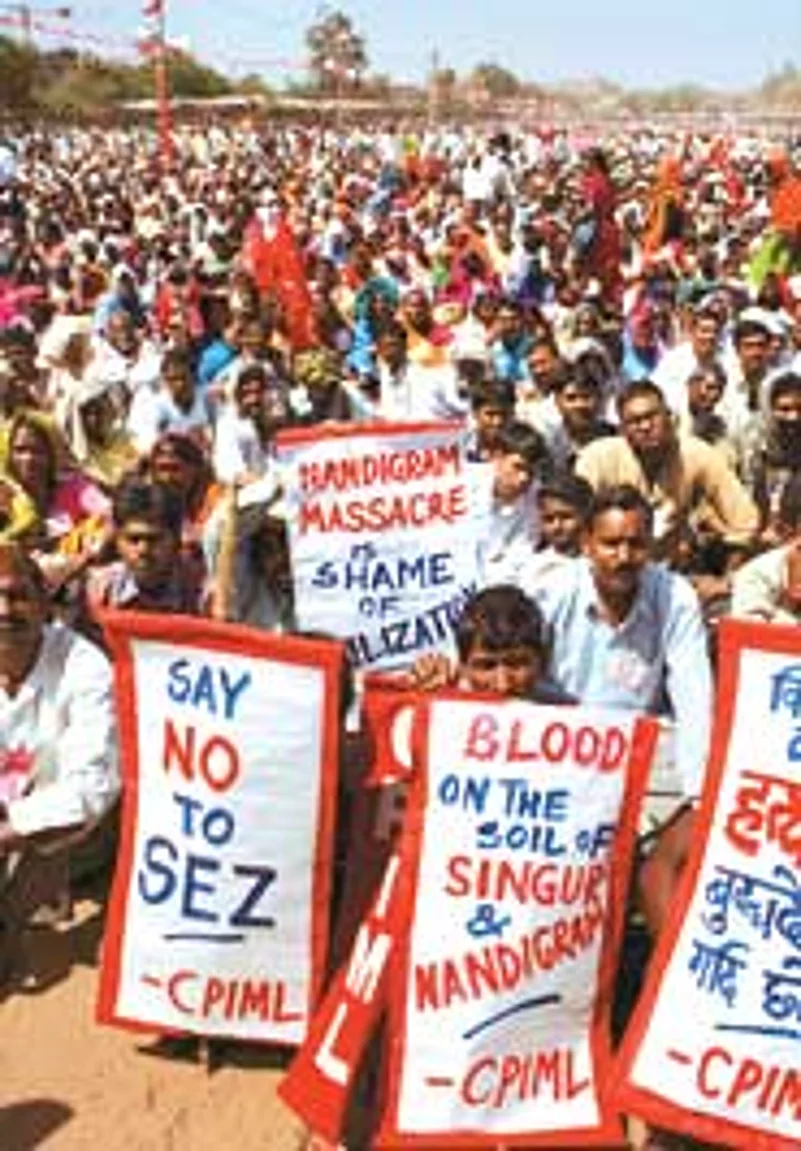- 467 SEZs formally approved till July 2008 by the Board of Approvals, Union ministry of commerce
- 225 of these SEZs have been notified across states
- Exports expected to touch Rs 1.25 lakh crore during 2008-09, an increase of over 86 per cent over the last fiscal
- Exports pegged at Rs 67,088 crore in 2007-08
- About 2.8 lakh people find employment with SEZs. Incremental employment generated in the last 3 yrs: over 150 per cent
***

| Fighting SEZs: Nandigram protests in West Bengal |
The economic argument for SEZs is powerful—low-cost, tax-free production of export-oriented goods and services that earn crores in forex and provide employment to lakhs. As "engines of India's growth", the SEZs are offered a pile of incentives, including 100 per cent FDI, "public utility" status, relief from labour and environmental laws, 15-year tax exemption on export profits, income tax exemption for any 10 years, exemption from service tax, customs duty and local taxes for imports, freedom to retain forex earnings, control over power and water. It's a sweet deal, especially when land use is considered.
The land acquired—SEZs range from 100 hectares to 25,000 ha—can be used according to the developer's persuasions with at least 35 per cent for industry/manufacturing. The April 2007 amendment, post-Nandigram, capped land holding at 5,000 ha but allowed case-by-case exemptions; it raised the use to 50 per cent while discouraging state governments from acquiring farmland on developers' behalf. Analysts fear that developers will turn the other half into gated cities with near-total control over them. "SEZs are nothing but the setting up of privately-owned urban agglomerates where Indian citizens can't enter without I-cards. To create these, we changed policy.Was it democratic? This is a strategy to exclude the poor from geographical spaces," says economic analyst Paranjoy Guha Thakurta.
Land issues evoke the fiercest arguments on both sides. Developers (and the commerce ministry) say one can't have massive-scale production sans large-scale land acquisitions and land-use changes. Affected farmers and critics say the SEZ Act is a mask for corporate landgrab and the establishment of private enclaves with permissions to violate laws and rights of workers. In states like Maharashtra, the SEZ developer—Raigad district alone will see nine SEZs covering 50,000 ha, Reliance's MahaMumbai being the largest—has extra powers as 'Special Planning and Township Authority' to develop, operate and maintain it. The government's rendered virtually redundant.
"We cannot arbitrarily apply rules to do what a handful of industrialists and real estate developers desire, because that undermines democratic functioning," says Guha. Independent researcher-writer Aseem Shrivastava, who closely tracks Chinese SEZs, says: "We are creating hundreds of 'Little Chinas' but by making our local and national laws irrelevant. Seen thus, SEZs are a refuge from constitutional 'hurdles', a waiver from democratic norms." The most controversial—and undemocratic—aspect has been the "real estate broker" role played by many state governments in forcibly acquiring farmland for "public purpose", at below market rates, under the draconian and outdated Land Acquisition Act, 1894. Says Guha Thakurta: "The State's role in creating this 'eminent domain' is reprehensible. What 'public purpose' is served in handing over land to Ambanis or XYZs?"
It's this clause of 'public purpose' that protesters across the country—from academics, activists, farmers to fisherfolk—are questioning. In Bhal Vithalwadi, one of the 45 villages planned as a Reliance SEZ, young graduate Vilas Mhatre is livid: "We fight for the smallest information from our own government but the company has detailed maps showing even a golf course on our land." Adml (retd) L. Ramdas, settled in sun-kissed Alibaug, spent last year organising 22 of the 45 villages. "My wife and I joined the ranks of oustees when the SEZ was notified," he wrote in a letter. "Over 500 princely states were merged with the Union of India in 1947; today we are rapidly recreating fiefdoms or 'Selective Exclusive Zamindaris'."
After the April 2007 amendment, the onus of land acquisition fell on SEZ developers. Developers like M&M recommend private negotiation; officials say it took six years to purchase land in Chennai but 98 per cent was through negotiations with farmers. The Gujarat government has a rule stayed away from the acquisition process; protests have been fewer. However, the amendment allows state governments to acquire 30 per cent if the developer has independently secured 70 per cent of the land required. Whether it's a notch higher on the democratic meter is debatable. Unofficial estimates say a whopping Rs 40,000 crore or more is stuck due to tardy land acquisition. But in a nation with 467 approved SEZs—and aiming for 600, against China's six—it's imprudent to ignore the social subtext of such a massive land transfer. Also, despite the fact that most earmarked land is fertile crop land, often two-crop land, the impact on agriculture hardly comes into SEZ debates.
In fact, India's tryst with economic zones predates China's. The first free trade zone (FTZ) at Kandla and the earliest export processing zones (EPZs) like the Santacruz Electronic Export Processing Zone (SEEPZ) in Mumbai were set up by the state itself. The 20 FTZs and EPZs were marred by few protests, unlike the mutinies today, perhaps because these zones were in the government domain. Many IT and ITes companies are located in EPZs, enjoying tax concessions scheduled to expire in 2009-10. Incidentally, half of the approved SEZs are for these sectors. Is this a mere coincidence?
The SEZ vision flows from China's Shenzhen, the fishing village transformed into a megacity (its exports of $70 billion in 2007 was half of all India's). The Chinese model succeeded because the system was typically Chinese. The world saw cheap goods but rarely heard of 14-hour workdays, oppressive working conditions, violation of environmental norms, suppression of protests. Two decades later, there is overcapacity and duplication of industries, flight of international capital as the government withdraws incentives and levies taxes. Analysts suggest that the Chinese SEZ story may be over. Here, it's beginning but, as Guha asserts, "it's foolish for democratic India to merely copy China".
While democratic norms are neatly sidestepped—both in policy and in implementation—democratic expressions abound in the million mutinies against Indian Shenzhens. For every SEZ, there are multiple protests. SEZ developers brand protesters as anti-development but, as Arun Shivkar of SAKAV, an umbrella organisation in Raigad, puts it: "We want development too but we're asking what's for us in SEZ development." Activists and economists, even former president A.P.J. Abdul Kalam, ask why affected people can't be made stakeholders, why people-led planning isn't considered and displacement kept down. The Moily panel of April 2008 had recommended all this, and more.
The two-year agitation in Raigad forced the Maharashtra government to declare last month that the SEZ will leave out 22 of the 45 marked villages, though a Reliance spokesperson denied modifications. The Goa Movement Against SEZs succeeded in the denotification of the proposed 18 SEZs, a first in itself. Though highly local and scattered, the protests—mostly peaceful, sometimes violent—represent grassroots democracy at its best: padayatras, jan andolans, songs and skits, recourse to courts and media, refusal to accept acquisition notices, using the rti and dharnas when land is forcibly acquired.
Perhaps, competing and contradictory interests can be accommodated in refined versions of SEZs, where the consent of affected people is mandatory and so on. But locked as the debate is now, this seems difficult. After all, Parliament passed the SEZ Bill in June 2005 virtually without debate. Since then, the debate has moved into public domain. Only, those who must listen pretend not to hear. After all, the notion of "free market democracy" must be nurtured even if it resembles "corporate totalitarianism" as a Chinese dissident described the SEZ phenomenon.

















